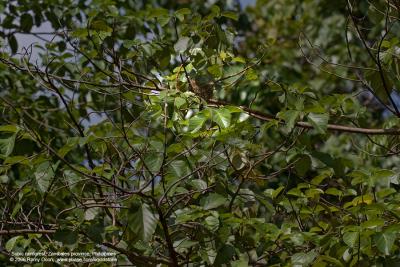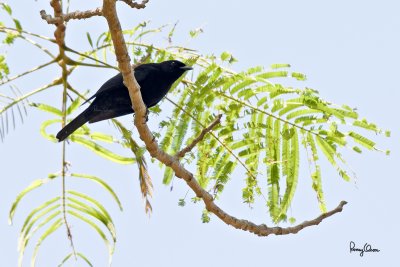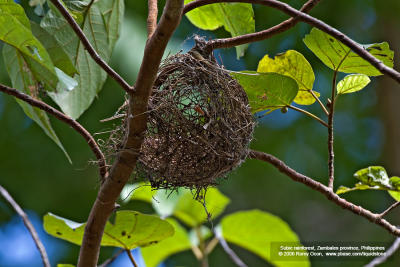![Balicassiao
(a Philippine endemic)
Scientific name - Dicrurus balicassius
Habitat - Forest and forest edge usually below 1200 m.
[20D + Sigmonster (Sigma 300-800 DG)]](https://a4.pbase.com/g3/41/379541/3/57282961.IMG_7170800x600.jpg)
IMG_7170-800x600.jpgBalicassiao
(a Philippine endemic)
Scientific name - Dicrurus balicassius
Habitat - Forest and forest edge usually below 1200 m.
[20D + Sigmonster (Sigma 300-800 DG)]
|
![Balicassiao
(a Philippine endemic)
Scientific name - Dicrurus balicassius
Habitat - Forest and forest edge usually below 1200 m.
[20D + Sigmonster (Sigma 300-800 DG)]](https://a4.pbase.com/g3/41/379541/3/57284611.IMG_7191800x400.jpg)
IMG_7191-800x400.jpgBalicassiao
(a Philippine endemic)
Scientific name - Dicrurus balicassius
Habitat - Forest and forest edge usually below 1200 m.
[20D + Sigmonster (Sigma 300-800 DG)]
|
![Balicassiao
(a Philippine endemic)
Scientific name - Dicrurus balicassius
Habitat - Forest and forest edge usually below 1200 m.
[20D + Sigmonster (Sigma 300-800 DG)]](https://a4.pbase.com/g3/41/379541/3/57284773.IMG_7186800x600.jpg)
IMG_7186-800x600.jpgBalicassiao
(a Philippine endemic)
Scientific name - Dicrurus balicassius
Habitat - Forest and forest edge usually below 1200 m.
[20D + Sigmonster (Sigma 300-800 DG)]
|

IMG_7199-900x600.jpgAn environmental view of the nest. |

IMG_7215-1200x800.jpgBlackish Cuckoo-Shrike (Coracina coerulescens, a Philippine endemic)
Habitat - Canopy of forest in the lowlands.
Shooting info - Subic rainforest, Bataan, March 14, 2006, 800 mm, f/9, ISO 200, 1/125 sec, 475B/3421 support
|
![Bar-bellied Cuckoo-shrike (Male)
Scientific name - Coracina striata striata
Habitat - Forest and forest edge.
[20D + Sigmonster (Sigma 300-800 DG)]](https://a4.pbase.com/g3/41/379541/3/57381706.IMG_7177750x500.jpg)
IMG_7177-750x500.jpgBar-bellied Cuckoo-shrike (Male)
Scientific name - Coracina striata striata
Habitat - Forest and forest edge.
[20D + Sigmonster (Sigma 300-800 DG)]
|
![Scale-feathered Malkoha
(a Philippine endemic)
Scientific name - Phaenicophaeus cumingi
Habitat - Forest, edge and second growth up to 2000 m.
[20D + Sigmonster (Sigma 300-800 DG)]](https://a4.pbase.com/g3/41/379541/3/57285665.IMG_7142720x540.jpg)
IMG_7142-720x540.jpgScale-feathered Malkoha
(a Philippine endemic)
Scientific name - Phaenicophaeus cumingi
Habitat - Forest, edge and second growth up to 2000 m.
[20D + Sigmonster (Sigma 300-800 DG)]
|
![White-eared Brown-dove
(a Philippine endemic)
Scientific name - Phapitreron leucotis
Habitat - Wide range, from second growth to montane forest to 1600 m.
[20D + Sigmonster (Sigma 300-800 DG), 1/30 sec without MLU, ISO 3200]](https://a4.pbase.com/g3/41/379541/3/57286503.IMG_7128800x600.jpg)
IMG_7128-800x600.jpgWhite-eared Brown-dove
(a Philippine endemic)
Scientific name - Phapitreron leucotis
Habitat - Wide range, from second growth to montane forest to 1600 m.
[20D + Sigmonster (Sigma 300-800 DG), 1/30 sec without MLU, ISO 3200]
|
![Blue-throated Bee-eater
Scientific name - Merops viridis
Habitat - Cleared fields adjacent to forest, open country and grasslands.
[1DM2 + 400 5.6L, hand held]](https://a4.pbase.com/g6/41/379541/3/57328213.tejA4MUZ.jpg)
KZ2L1993-800x600.jpgBlue-throated Bee-eater
Scientific name - Merops viridis
Habitat - Cleared fields adjacent to forest, open country and grasslands.
[1DM2 + 400 5.6L, hand held] |
![Grey Wagtail
Scientific name - Motacilla cinerea
Habitat - Streams and forest roads at all elevations.
[20D + Sigmonster (Sigma 300-800 DG)]](https://a4.pbase.com/g3/41/379541/3/57324353.IMG_7330800x600.jpg)
IMG_7330-800x600.jpgGrey Wagtail
Scientific name - Motacilla cinerea
Habitat - Streams and forest roads at all elevations.
[20D + Sigmonster (Sigma 300-800 DG)]
|
![Grey Wagtail
Scientific name - Motacilla cinerea
Habitat - Streams and forest roads at all elevations.
[20D + Sigmonster (Sigma 300-800 DG)]](https://a4.pbase.com/g3/41/379541/3/57323857.IMG_7297800x400.jpg)
IMG_7297-800x400.jpgGrey Wagtail
Scientific name - Motacilla cinerea
Habitat - Streams and forest roads at all elevations.
[20D + Sigmonster (Sigma 300-800 DG)]
|
![Blue-throated Bee-eater
Scientific name - Merops viridis
Habitat - Cleared fields adjacent to forest, open country and grasslands.
[1DM2 + 400 5.6L, hand held]](https://a4.pbase.com/g3/41/379541/3/57350295.KZ2L1972600x900.jpg)
KZ2L1972-600x900.jpgBlue-throated Bee-eater
Scientific name - Merops viridis
Habitat - Cleared fields adjacent to forest, open country and grasslands.
[1DM2 + 400 5.6L, hand held]
|
![Green Imperial-Pigeon
Scientific name - Ducula aenea aenea
Habitat - Lowland and middle elevation forest.
[20D + Sigmonster (Sigma 300-800 DG) + Sigma 2x TC, 1600 mm, 60++ m distance]](https://a4.pbase.com/g3/41/379541/3/57305850.IMG_7401800x600.jpg)
IMG_7401-800x600.jpgGreen Imperial-Pigeon
Scientific name - Ducula aenea aenea
Habitat - Lowland and middle elevation forest.
[20D + Sigmonster (Sigma 300-800 DG) + Sigma 2x TC, 1600 mm, 60++ m distance]
|
![Green Imperial-Pigeon
Scientific name - Ducula aenea aenea
Habitat - Lowland and middle elevation forest.
[20D + Sigmonster (Sigma 300-800 DG) + Sigma 2x TC, 1600 mm, 60++ m distance]](https://a4.pbase.com/g3/41/379541/3/57305442.IMG_7401100crop.jpg)
IMG_7401-100crop.jpgGreen Imperial-Pigeon
Scientific name - Ducula aenea aenea
Habitat - Lowland and middle elevation forest.
[20D + Sigmonster (Sigma 300-800 DG) + Sigma 2x TC, 1600 mm, 60++ m distance]
|
![Blue-throated Bee-eater
Scientific name - Merops viridis
Habitat - Cleared fields adjacent to forest, open country and grasslands.
[1DM2 + 400 5.6L, hand held]](https://a4.pbase.com/g3/41/379541/3/57346508.KZ2L2039800x400.jpg)
KZ2L2039-800x400.jpgBlue-throated Bee-eater
Scientific name - Merops viridis
Habitat - Cleared fields adjacent to forest, open country and grasslands.
[1DM2 + 400 5.6L, hand held]
|
![Green Imperial-Pigeon
Scientific name - Ducula aenea aenea
Habitat - Lowland and middle elevation forest.
[20D + Sigmonster (Sigma 300-800 DG) + Sigma 2x TC, 1600 mm, 60++ m distance]](https://a4.pbase.com/g3/41/379541/3/57344126.IMG_7399800x600.jpg)
IMG_7399-800x600.jpgGreen Imperial-Pigeon
Scientific name - Ducula aenea aenea
Habitat - Lowland and middle elevation forest.
[20D + Sigmonster (Sigma 300-800 DG) + Sigma 2x TC, 1600 mm, 60++ m distance]
|
![Blue-throated Bee-eater
Scientific name - Merops viridis
Habitat - Cleared fields adjacent to forest, open country and grasslands.
[1DM2 + 400 5.6L, hand held]](https://a4.pbase.com/g3/41/379541/3/57322033.KZ2L2094800x400.jpg)
KZ2L2094-800x400.jpgBlue-throated Bee-eater
Scientific name - Merops viridis
Habitat - Cleared fields adjacent to forest, open country and grasslands.
[1DM2 + 400 5.6L, hand held]
|
![Bar-bellied Cuckoo-shrike (Female)
Scientific name - Coracina striata striata
Habitat - Forest and forest edge.
[20D + Sigmonster (Sigma 300-800 DG)]](https://a4.pbase.com/g3/41/379541/3/57325268.IMG_7213800x600.jpg)
IMG_7213-800x600.jpgBar-bellied Cuckoo-shrike (Female)
Scientific name - Coracina striata striata
Habitat - Forest and forest edge.
[20D + Sigmonster (Sigma 300-800 DG)] |

IMG_7209-900x600.jpgThe empty nest seen from below. In a few more days, I expect the mother Balicassiao to lay some eggs in it. |
![Balicassiao
(a Philippine endemic, nesting)
Scientific name - Dicrurus balicassius
Habitat - Forest and forest edge usually below 1200 m.
[20D + Sigmonster (Sigma 300-800 DG)]](https://a4.pbase.com/g3/41/379541/3/57662152.IMG_7764800x600.jpg)
IMG_7764-800x600.jpgBalicassiao
(a Philippine endemic, nesting)
Scientific name - Dicrurus balicassius
Habitat - Forest and forest edge usually below 1200 m.
[20D + Sigmonster (Sigma 300-800 DG)]
|

IMG_7774-800x600.jpgBALICASSIAO NEST SEEN FROM THE BOTTOM. A cluster of three eggs can be seen outlined against the
bright sky in this March 21 photo. As of March 14, the newly completed nest was empty.
To have an idea of relative size of the eggs and nest, I carefully compared objects of known size at similar distance from me as the nest.
In my best estimate, the diameter of the branch to which the nest is attached is about 20 mm. |
![Blue-throated Bee-eater
Scientific name - Merops viridis
Habitat - Cleared fields adjacent to forest, open country and grasslands.
[1DM2 + 400 5.6L, hand held]](https://a4.pbase.com/g4/41/379541/3/64062296.1mnMJIed.jpg)
KZ2L1978-750x500.jpgBlue-throated Bee-eater
Scientific name - Merops viridis
Habitat - Cleared fields adjacent to forest, open country and grasslands.
[1DM2 + 400 5.6L, hand held]
|











